The paradise fish (Macropodus opercularis), also known as the paradise gourami, is one of the most captivating freshwater fish in the aquarium hobby. Known for its vibrant colors, hardy nature, and fascinating behavior, this species has been a favorite among aquarists for over a century. It was one of the first tropical fish introduced to the Western aquarium trade in the 19th century, making it a pioneer in ornamental fishkeeping. Whether you’re a beginner or an experienced aquarist, the paradise fish offers a unique blend of beauty and personality that makes it a standout addition to any tank.
Native to East Asia, the paradise fish thrives in a variety of freshwater habitats, from rice paddies to slow-moving streams and ponds. Its adaptability and resilience make it an excellent choice for aquarists who want a low-maintenance yet visually striking fish. However, this species is not without its challenges. Known for its territorial and sometimes aggressive behavior, the paradise fish requires careful consideration when it comes to tank mates and habitat setup.
Let’s explore everything you need to know about the paradise fish, including its care requirements, habitat preferences, diet, and behavior. Delve into its various color morphs, such as the blue paradise fish and the albino paradise gourami, to help you decide which variation is the best fit for your aquarium.
What Makes the Paradise Fish Special?
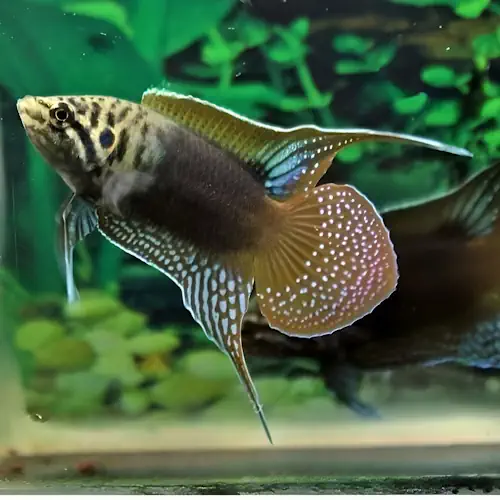
The paradise fish is a member of the gourami family (Osphronemidae), a group of labyrinth fish known for their ability to breathe air directly from the surface using a specialized organ called the labyrinth organ. This adaptation allows them to survive in oxygen-poor waters, making them incredibly hardy and versatile.
Visually, the paradise fish is a showstopper. Its body is adorned with alternating stripes of red and blue, creating a striking contrast that catches the eye. Males are particularly vibrant, with elongated fins and more intense coloration, especially during breeding season. Females, while less colorful, are equally charming with their rounded bodies and shorter fins.
There are several color variations of the paradise fish, including the blue paradise fish, which features a more subdued blue hue, and the albino paradise gourami, characterized by its pale pink and white coloration with red eyes. These variations add diversity to the species, allowing aquarists to choose a fish that suits their aesthetic preferences.
Natural Habitat and Distribution
The paradise fish is native to East Asia, with its range extending from the Korean Peninsula to northern Vietnam and parts of China. It inhabits a wide variety of freshwater environments, including:
- Rice paddies
- Slow-moving streams
- Ponds
- Backwaters of rivers
These habitats are often shallow and densely vegetated, providing plenty of hiding spots and opportunities for foraging. The fish’s adaptability to different water conditions has contributed to its widespread distribution and popularity in the aquarium trade.
Tank Setup and Habitat Requirements
Creating a suitable environment for your paradise fish is crucial for its health and well-being. Here are the key factors to consider:
Tank Size
A single paradise fish can thrive in a tank as small as 20 gallons, but a larger tank is recommended if you plan to keep multiple fish or other tank mates. The additional space helps reduce territorial aggression.
Water Parameters
Paradise fish are highly adaptable but prefer the following conditions:
- Temperature: 74°F to 82°F (23°C to 28°C)
- pH: 6.0 to 8.0
- Hardness: Soft to moderately hard water
They can tolerate fluctuations in water quality, but consistent parameters are ideal for long-term health.
Substrate and Decor
A natural-looking tank setup with a sandy or fine gravel substrate is ideal. Add plenty of plants, driftwood, and rocks to mimic their natural habitat. Floating plants are particularly beneficial, as they provide shade and help diffuse light, creating a more comfortable environment for the fish.
Filtration and Aeration
While paradise fish can breathe air directly, a good filtration system is still essential to maintain water quality. Avoid strong currents, as these fish prefer calm waters.
Diet and Feeding
Paradise fish are omnivorous and have a hearty appetite. In the wild, they feed on small insects, larvae, and plant matter. In captivity, they thrive on a varied diet that includes:
- High-quality pellets or flakes
- Frozen or live foods like brine shrimp, bloodworms, and daphnia
- Occasional vegetable matter, such as blanched spinach or zucchini
Feeding them a diverse diet ensures they receive all the nutrients they need to maintain their vibrant colors and overall health.
Behavior and Compatibility
One of the most fascinating aspects of the paradise fish is its behavior. These fish are known for their intelligence and curiosity, often interacting with their surroundings and even recognizing their owners. However, they can also be territorial and aggressive, especially males.
Tank Mates
Choosing the right tank mates is critical. Avoid keeping paradise fish with smaller, timid species or other aggressive fish. Suitable tank mates include:
- Larger, semi-aggressive species like barbs or larger tetras
- Bottom-dwelling fish like loaches or catfish
It’s best to avoid housing multiple male paradise fish in the same tank, as they are likely to fight over territory.
Breeding Paradise Fish
Breeding paradise fish can be a rewarding experience for aquarists. These fish are bubble nest builders, with males constructing nests at the water’s surface using bubbles and plant material. Here’s a brief overview of the breeding process:
- Conditioning: Feed the male and female a high-protein diet to prepare them for breeding.
- Spawning Tank: Set up a separate tank with shallow water, floating plants, and a temperature of around 80°F (27°C).
- Courtship: The male will display vibrant colors and perform a courtship dance to attract the female.
- Egg Laying: Once the female lays eggs, the male collects them and places them in the bubble nest.
- Parental Care: The male guards the nest and tends to the eggs until they hatch, usually within 24-48 hours.
After hatching, the fry should be fed infusoria or liquid fry food until they are large enough to eat baby brine shrimp.
Popular Variations: Blue and Albino Paradise Fish

The paradise fish has several color morphs that add variety to its already stunning appearance:
- Blue Paradise Fish: This variation features a more subdued blue coloration, making it a subtle yet elegant choice for aquarists.
- Albino Paradise Gourami: With its pale pink and white body and red eyes, the albino paradise fish is a striking and unique addition to any tank. Its care requirements are similar to the standard paradise fish, making it equally hardy and easy to maintain.

Key Differences Between Blue Paradise Fish and Albino Paradise Gourami
| Feature | Blue Paradise Fish | Albino Paradise Gourami |
|---|---|---|
| Coloration | The blue paradise fish has alternating vivid blue and red stripes across its body, creating a striking contrast. | The albino paradise gourami features white, pink, and pale blue stripes, with a more subdued appearance. |
| Eyes | Blue paradise fish have dark eyes, typical of most fish in this species. | Albino paradise gouramis have pink or red eyes, a hallmark of albinism. |
| Brightness of Colors | The blue paradise fish is known for its intense, shiny blue hues, especially in males, which are more vibrant during breeding. | The albino variation lacks the darker pigments, resulting in a softer, pastel-like appearance. |
| Behavioral Traits | Both variations share similar behaviors, but the blue paradise fish may appear more aggressive due to its territorial displays, which are accentuated by its bold colors. | The albino paradise gourami exhibits similar aggression levels but may appear less intimidating due to its lighter coloration. |
| Popularity | The blue paradise fish is more commonly kept due to its classic, vibrant appearance and historical popularity in the aquarium trade. | The albino paradise gourami is less common and often sought after by aquarists looking for a unique or rare variation. |
Shared Characteristics
Despite their differences, both the blue paradise fish and albino paradise gourami share several traits, as they belong to the same species:
- Size: Both grow to about 3-4 inches in length, with males being slightly larger and having longer fins.
- Labyrinth Organ: Both are labyrinth fish, meaning they can breathe atmospheric air, allowing them to survive in low-oxygen environments.
- Aggression: Both variations are territorial, especially males, and require careful selection of tank mates to avoid conflicts.
- Hardiness: Both are hardy fish that can tolerate a wide range of water conditions, including temperatures from 60°F to 86°F (16°C to 30°C) and pH levels between 6.0 and 8.0.
Which Should You Choose?
The choice between the blue paradise fish and the albino paradise gourami largely depends on personal preference:
- If you prefer vivid, bold colors and a more traditional look, the blue paradise fish is an excellent choice.
- If you’re drawn to unique, softer hues and want a rarer variation, the albino paradise gourami may be more appealing.
Both are stunning additions to an aquarium, but their territorial nature means they are best suited for tanks with ample space, hiding spots, and carefully chosen tank mates.
Conclusion
The paradise fish is a timeless classic in the aquarium hobby, offering a perfect blend of beauty, resilience, and fascinating behavior. Whether you’re drawn to the vibrant stripes of the standard paradise fish, the elegance of the blue variation, or the unique charm of the albino morph, this species is sure to captivate you.
By understanding their care requirements, habitat preferences, and behavior, you can create a thriving environment for these stunning fish. With proper care, the paradise fish can live up to five years or more, providing endless enjoyment and a splash of color to your aquarium.

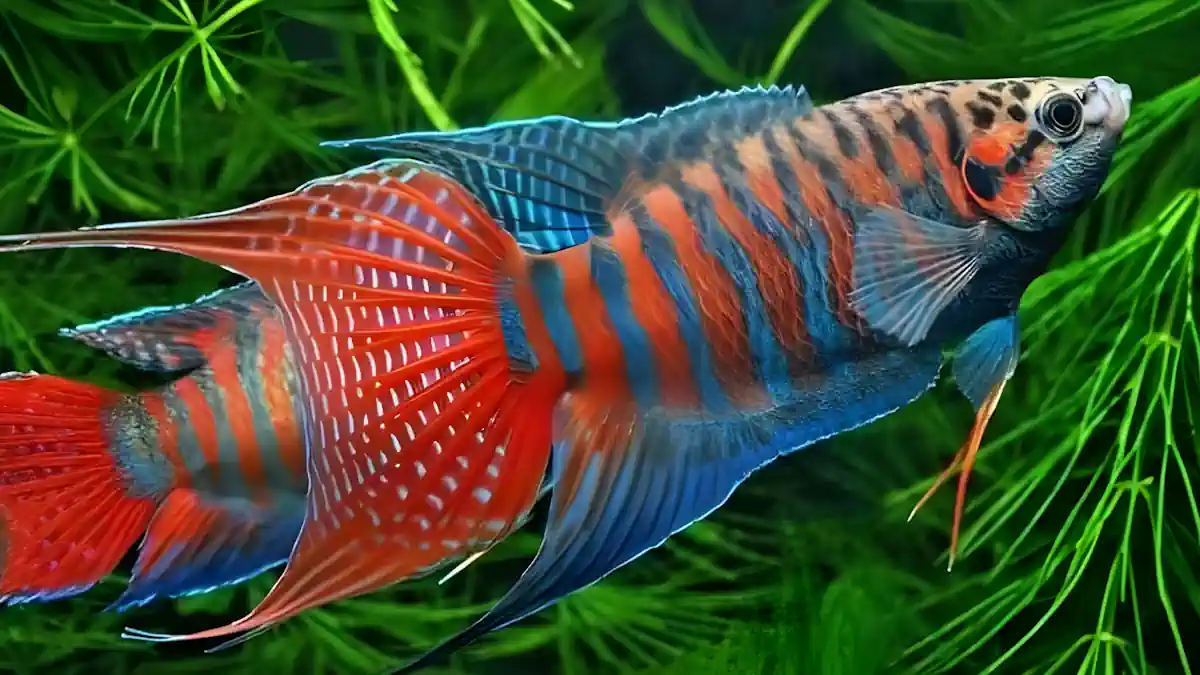
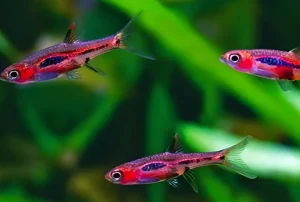
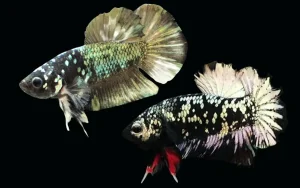
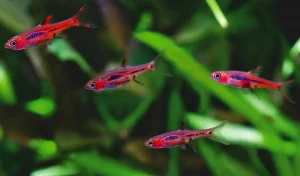
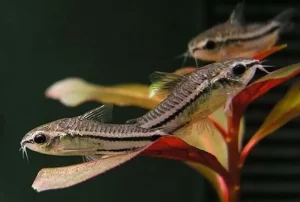



Leave a Comment